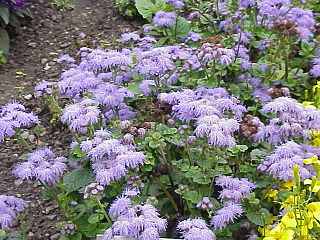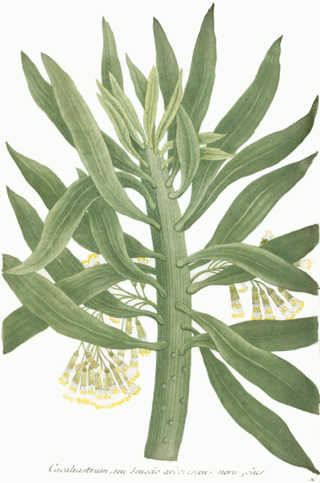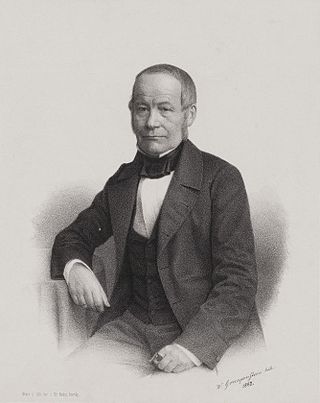
HMS Resolute was a mid-19th-century barque-rigged ship of the British Royal Navy, specially outfitted for Arctic exploration. Resolute became trapped in the ice searching for Franklin's lost expedition and was abandoned in 1854. Recovered by an American whaler, she was returned to Queen Victoria in 1856. Timbers from the ship were later used to construct the Resolute desk which was presented to the President of the United States and is located in the White House Oval Office.

Berthold Carl Seemann was a German botanist. He travelled widely and collected and described plants from the Pacific and South America.

Eupatorieae is a tribe of over 2000 species of plants in the family Asteraceae. Most of the species are native to tropical, subtropical, and warm temperate areas of the Americas, but some are found elsewhere. Well-known members are Stevia rebaudiana, a number of medicinal plants (Eupatorium), and a variety of late summer to autumn blooming garden flowers, including Ageratum (flossflower), Conoclinium (mistflower), and Liatris.
William Arthur was a Royal Navy officer after whom Port Arthur in China was named.

Vice Admiral Sir Henry Kellett, was an Irish naval officer and explorer.

Vice Admiral Sir Henry Mangles Denham was a Royal Navy officer who went on to be Commander-in-Chief, Pacific Station.

Senecio arborescens is a flowering plant in the aster family, but the available information about it is mostly conflicting and old.

Zamia pseudoparasitica is a species of plant in the family Zamiaceae. It is endemic to Panama.

Admiral Sir Richard Vesey Hamilton was a Royal Navy officer. As a junior officer he twice volunteered to take part in missions to search for Sir John Franklin's ill-fated expedition to find the Northwest Passage. He also took part in the Battle of Fatshan Creek in June 1857 during the Second Opium War.

Hofmeisteria is a genus of Mexican flowering plants in the family Asteraceae.

Bedford Clapperton Trevelyan Pim was a Royal Navy officer, Arctic explorer, barrister, and author. He was the first man who travelled from a ship on the eastern side of the Northwest Passage to one on the western side.
Samuel Gurney Cresswell, was a Royal Navy officer. He was technically the first naval officer to cross the entire Northwest Passage. Robert McClure was in charge of the expedition but Cresswell reached England first.

The era of European and American voyages of scientific exploration followed the Age of Discovery and were inspired by a new confidence in science and reason that arose in the Age of Enlightenment. Maritime expeditions in the Age of Discovery were a means of expanding colonial empires, establishing new trade routes and extending diplomatic and trade relations to new territories, but with the Enlightenment scientific curiosity became a new motive for exploration to add to the commercial and political ambitions of the past. See also List of Arctic expeditions and List of Antarctic expeditions.

HMS Herald was an Atholl-class 28-gun sixth-rate corvette of the Royal Navy. She was launched in 1822 as HMS Termagant, commissioned in 1824 as HMS Herald and converted to a survey ship in 1845. After serving as a chapel ship from 1861, she was sold for breaking in 1862.

Echinocereus subinermis is a species of flowering plant in the cactus family Cactaceae, native to north, northwestern, and central Mexico.

Joachim Steetz was a German botanist. His herbarium, comprising more than 5000 specimens from over 160 collectors and 30 countries was purchased in 1863 by Victorian Government Botanist Ferdinand von Mueller for the sum of 80 pounds. The collection is currently housed at the National Herbarium of Victoria. The herbarium was compiled by Steetz over more than thirty years and comprises 160 collectors from more than 30 countries, including type specimens from plant collectors of the time including:

HMS Pandora was a 3-gun brig of the Royal Navy, in service from 1833 to 1862.

The Ross expedition was a voyage of scientific exploration of the Antarctic in 1839 to 1843, led by James Clark Ross, with two unusually strong warships, HMS Erebus and HMS Terror. It explored what is now called the Ross Sea and discovered the Ross Ice Shelf. On the expedition, Ross discovered the Transantarctic Mountains and the volcanoes Mount Erebus and Mount Terror, named after each ship. The young botanist Joseph Dalton Hooker made his name on the expedition.

The Metropolitan Archcathedral Basilica of Santa María la Antigua is a Catholic church located in the old town of Panama City in Panama. It was consecrated in 1796, although construction work began in 1688, 108 years earlier. It was designed by the military engineer Nicolás Rodríguez. The archcathedral is the episcopal see of the Metropolitan Archdiocese of Panama.

Croton pottsii is a species of plant known by the common name leatherweed. It is native to the southwestern United States and northern Mexico.

















